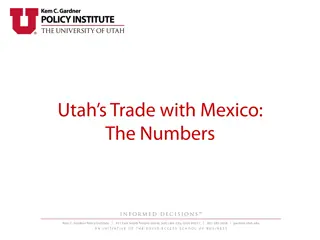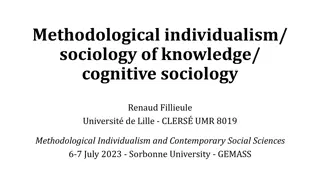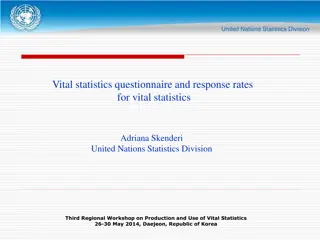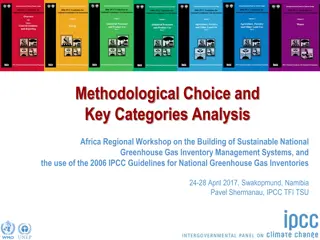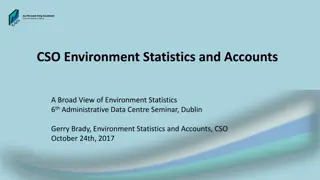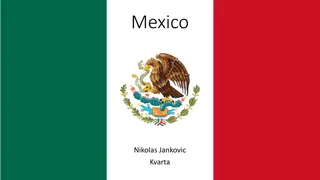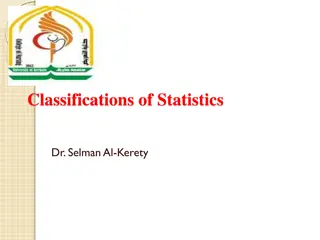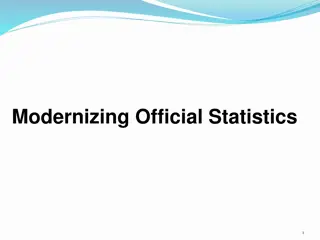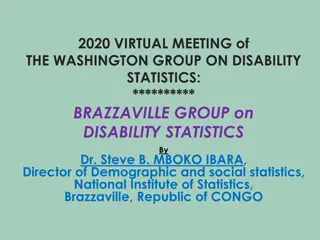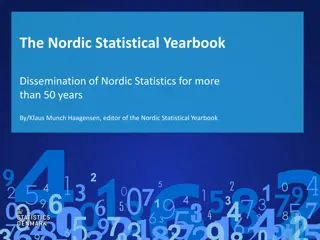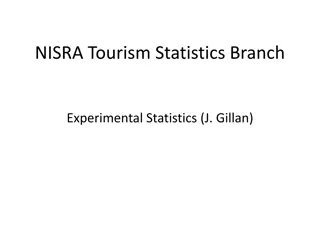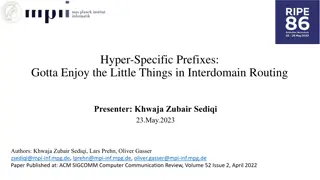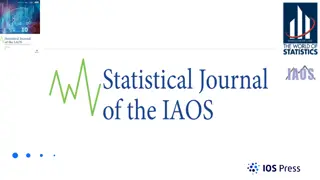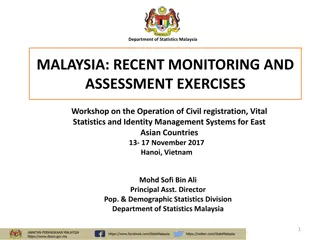Understanding Time Use Statistics in Mexico: Best Practices and Methodological Insights
Exploring the methodological features, surveys conducted, representativity considerations, and basic concepts underlying time use statistics in Mexico. The study focuses on how individuals allocate their time in daily activities, encompassing all types of work within households. Various surveys and tools used for data collection are discussed, shedding light on the comprehensive approach taken to understand time use patterns in the Mexican context.
Download Presentation

Please find below an Image/Link to download the presentation.
The content on the website is provided AS IS for your information and personal use only. It may not be sold, licensed, or shared on other websites without obtaining consent from the author. Download presentation by click this link. If you encounter any issues during the download, it is possible that the publisher has removed the file from their server.
E N D
Presentation Transcript
Time use statistics: Best practices from the Mexican Case International Seminar on Gender Statistics, Incheon Korea 12-13 November 2013 Jimena Tovar
Methodological Features Objectives: To measure how individuals,12 years old and older, allocate their time in daily activities. Measures all kinds of work, remunerated and non-renumerated in households. Sample size: 17,000 households: all their memebers,12 years and older, were included (44,505 individuals) Date: October 12th-November 20th of 2009 Target population: Individuals, 12 years old and older
Time use surveys in Mexico INEGI has done 4 surveys of time use: ENTAUT, 1996 ENUT, 1998 ENUT, 2002 ENUT, 2009 The first 3 were included in household surveys of income and expenditure, while ENUT 2009 was sponsored as a joint survey, between INEGI and and the National Institute of Women in Mexico (INMUJERES).
Methodology Representativity: At the national level Stratification in terms of urban and rural areas (less than 2500 inhabitants)
The concept of time use is based on: Undertaken by INEGI, representative of the Mexican reality (relevant for transition economies) CMAUT International standard, possibly of limited analytical capacity to explain the cases of transition economies and developing countries ICATUS 5 5
Basic concepts Conceptual definitions underpinning CMAUT Labor: human, physical and mental effort, used in creation of goods and services. Productive activities: Those that can be done by another person. Includes remunerated and non-remunerated work. Non productive (personal) activities: Non-productive or personal activites are those that can only be carried out effectively, by the individual benefiting from them. They are non-work activities connected with personal development, culture, entertainment, and use of communications media, as well as activites related to biological needs. 6
Instrument to capture informacin Electronic questionnarie System CAPI ( Computer Assisted Personal Interviewing) 7 7
Instrument to capture information Printed questionnaire This instrument substitutes the use of computer if there is damage, lack of battery, insecure areas, etc. 8
Sections of the questionnaire I. Characteristics and furnishings of the dwelling II. Identification of households and furnishings of the dwelling III. Socio-demographic features IV. Labor force participation and other occupational features V. Household members activities VI. Activities of members older than 12 years old, that are not part of the household, but provide support to household activities (or to take care of one of its members).
Results: Percentage of households in which at least one of its members require care
Percentage of individuals who require in terms of age or health condition 11
Provision of remunerated and non-remunerated labor, by gender and age group Remunerated labor Non-remunerated labor Age Group Age Group 60 y m s more 22.0 47.2 60 and 40.5 17.9 60 y m s 60 and more 34.5 54.6 52.1 18.0 50-59 50-59 60.5 20.1 37.5 57.2 40-49 Female 40-49 Male 70.6 22.8 30-39 37.6 56.8 30-39 57.8 18.5 20-29 36.4 52.6 20-29 26.0 12.8 12-19 23.4 34.3 12-19 Average weekly hours Average weekly hours
Provision of remunerated and non-remunerated labor Average weekly hours Total 44.1 36.1 Female 34.0 51.6 Male 51.9 18.2 Trabajo no remunerado Non- remunerated labor Trabajo remunerado Remunerated labor
Provision of non-remunerated labor, by type of activity and sex Average weekly hours Trabajo Dom stico Domestic work 20.6 19.2 7.1 Total Care and support to memebers in the household Cuidado y apoyo a integrantes del hogar Mujeres Female 30.4 24.7 8 Apoyo a otros hogares, a la comunidad y trabajo voluntario Support to other households , to the community and voluntary work Hombres Male 8.8 12.3 5.4
Provision of domestic work, by gender and age group Domestic work Age Group 60 and 30.6 10.3 60 y m s more 38.1 10.1 50-59 39 9.7 40-49 Mujeres Women Hombres Men 37.1 9.4 30-39 27.7 8.4 20-29 14.7 6.7 12--19 Average weekly hours
Provision of care and support to members of the household, by sex and age group Care and help of members of the household Age Group 14.8 11.4 60 y m s 60 and more 16 10.6 50-59 23.4 13.2 40-49 Mujeres Female Hombres Male 35.9 16.5 30-39 33.3 13.1 20-29 13.7 8.2 12--19 Average weekly hours
Provisionof care and support to members of the household, by activity and sex Support and care to: Disabilities and illness Discapacitados y enfermos (cr nicos y temporales) (chronic and temporal) 27.5 15.6 Less than 6 years (exclusive activities) Menores de 6 a os (actividades exclusivas) 12.5 5.5 Mujeres Female Less than 15 years old Hombres Male Menores de 15 a os (incluye algunas actividades que competen tambien a menores de 6 a os) 22.7 10.4 60 and more years 18.9 14.5 60 y m s a os Otros integrantes Other members 7.7 6.9 Average weekly hours
Provision of care and support to members of the household, by activity, position in the hosuehold, and sex Head of the household female or male Support and care to: Discapacitados y enfermos (cr nicos y temporales) (chronic and temporary) 30.0 16.7 Disabilities and illness Less than 6 year old Menores de 6 a os (actividades exclusivas) (exclusive activities) 9.9 5.5 Mujeres female Less than 15 years old Menores de 15 a os 22.9 11.8 Hombres Male (incluye algunas actividades que competen tambien a menores de 6 a os) 60 and more 24.7 16.4 60 y m s a os Other memebers 7.6 7.4 Otros integrantes Average weekly hours
Provision of care and support to members of the household by activity and sex Couple Support and care to: Discapacitados y enfermos (cr nicos y temporales) (chronic and temporary) 32.5 25.7 Disabilities and ill Less than 6 year old Menores de 6 a os (actividades exclusivas) (exclusive activites) 13.4 6.8 Mujeres Female Male Less than 15 years old Menores de 15 a os 26.6 15.3 Hombres (incluye algunas actividades que competen tambien a menores de 6 a os) 60 and more 18.7 4.5 60 y m s a os Other members 8.0 7.3 Otros integrantes Average weekly hours
Provision of care and support to members of the household: by activity, postition in the household, and sex Hijos e hijas Sons and daughters Support and care to: Discapacitados y enfermos (cr nicos y temporales) temporary) 16.9 13.3 Disabilities and ill (chronic and Less than 6 year old (exclusive activities) Menores de 6 a os (actividades exclusivas) Mujeres Female 10.7 4.3 Hombres Male Menores de 15 a os Less than 15 year old 14.6 6.9 (incluye algunas actividades que competen tambien a menores de 6 a os) 60 and more 17.8 13.6 60 y m s a os Other members 7.5 6.3 Otros integrantes Average weekly hours
Provision of support: to other households, to the community, or to voluntary work, by age Support to other households, to the community or voluntary work Age Group 60 and 11.8 8.1 60 y m s more 11.6 7.5 50-59 10.5 5.9 40-49 Mujeres Female Hombres Male 6.2 4.7 30-39 6.3 4.9 20-29 5 3.8 12--19 Average weekly hours
In 2010, the World Bank honored ENUT 2009: third place in the II Regional Award for Innovation in Statistics in Latin America and The Caribbean (together with Brazil). 23
Conclusions INEGI has followed the international organizations recommendations (ICATUS) In ENUT 2009 INEGI introduced the electronic questionnaire nevertheless we still use the traditional in rural areas in order to obtain a complete scenario of Mexico. INEGI produces the satellite account of non-remunerated labor.
Conociendo Mxico 01 800 111 46 34 www.inegi.org.mx atencion.usuarios@inegi.org.mx INEGI Informa @inegi_informa





